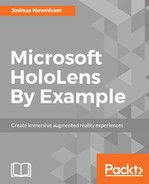Holographic Remoting allows you to stream your application to the device. It behaves as if it was running on the device while skipping the time-consuming build and deployment processes.
To use remoting, you must first download and install the companion HoloLens application Holographic Remoting Player, available at https://www.microsoft.com/en-us/store/p/holographic-remoting-player/9nblggh4sv40. Once installed, launch the application, where you will be presented with a screen similar to the following screenshot:

With the HoloLens running the remoting player, return to the Unity Editor and select Remote to Device from the Emulation Mode drop-down on the Holographic panel. Enter the IP address shown in HoloLens into the Remote Machine field and click Connect, as shown in the following screenshot:

If successful, Connection Status will turn green and you are ready to go. With the device now connected, every time you click on Play within the Unity Editor, your application will be streamed to the HoloLens device. You can pause, inspect, and debug as you would normally do while running your game in the Editor.
Some known limitations taken from the official Unity website include:
- Speech (PhraseRecognizer) is not supported via remote to the device; instead, it intercepts speech from the host machine running the Unity Editor
- While remote to device is running, all the audio on the host machine redirects to the device, including the audio from outside your application
Their simplicity, convenience, and speed make these tools a necessity when developing for the HoloLens. Next, we will discuss deploying to the emulator and device from Visual Studio; but before this, we will quickly summarize building a HoloLens from Unity, which will result in a Visual Studio solution.
